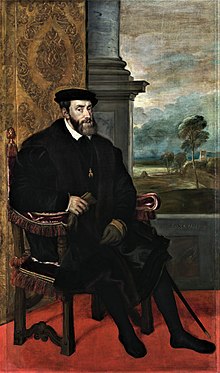
Back Cuius regio, eius religio Breton Cuius regio, eius religio Czech Cuius regio, eius religio Danish Cuius regio, eius religio German Kies reganto, ties religio Esperanto Cuius regio, eius religio Spanish Cuius regio, eius religio Finnish Cujus regio, ejus religio French Cuius regio, eius religio ID Cuius regio, eius religio Italian
This article's tone or style may not reflect the encyclopedic tone used on Wikipedia. (February 2024) |

Cuius regio, eius religio (Ecclesiastical Latin: [ˈku.jus ˈre.d͡ʒi.o ˈe.jus reˈli.d͡ʒi.o]) is a Latin phrase which literally means "whose realm, their religion" – meaning that the religion of the ruler was to dictate the religion of those ruled. This legal principle marked a major development in the collective (if not individual) freedom of religion within Western civilization. Before tolerance of individual religious divergences became accepted, most statesmen and political theorists took it for granted that religious diversity weakened a state[1] – and particularly weakened ecclesiastically-transmitted control and monitoring in a state.[2] The principle of "cuius regio" was a compromise in the conflict between this paradigm of statecraft and the emerging trend toward religious pluralism (coexistence within a single territory) developing throughout the German-speaking lands of the Holy Roman Empire. It permitted assortative migration of adherents to two religious groups, Roman Catholic and Lutheran, eliding other confessions.
At the Peace of Augsburg of 1555, which ended a period of armed conflict between Roman Catholic and Protestant forces within the Holy Roman Empire, the rulers of the German-speaking states and the Holy Roman Emperor, Charles V, agreed to accept this principle. In practice the principle had already been implemented between the time of the Nuremberg Religious Peace of 1532 and the 1546–1547 Schmalkaldic War. Now legal in the de jure sense, it was to apply to all the territories of the Empire except for the Ecclesiastical principalities and some of the cities in those ecclesiastical states, where the question of religion was addressed under the separate principles of the reservatum ecclesiasticum and the Declaratio Ferdinandei, which also formed part of the Peace of Augsburg. This agreement marked the end of the first wave of organized military action between Protestants and Catholics; however, these principles were factors during the wars of the 1545–1648 Counter-Reformation.
This left out other Reformed forms of Christianity (such as Calvinism) and radical systems such as Anabaptism. However, some non-Lutherans passed for Lutherans with the assistance of the Augsburg Confession Variata. Practices other than the two which were the most widespread in the Empire was expressly forbidden, considered by the law to be heretical, and could be punishable by death.[3] Although "cuius regio" did not explicitly intend to allow the modern ideal of "freedom of conscience", individuals who could not subscribe to their ruler's religion were permitted to leave his territory with their possessions. Also under the Declaratio Ferdinandei, Lutheran knights were given the freedom to retain their religion wherever they lived. The revocation of the Declaratio Ferdinandei by the Catholics in the 1629 Edict of Restitution helped fuel the Thirty Years' War of 1618–1648. The Edict of Restitution itself was overturned in the 1635 Peace of Prague, which restored the 1555 terms of the Peace of Augsburg. Stability brought by assortative migrations under the principle were threatened by subsequent conversion of rulers. Therefore, the Peace of Westphalia preserved the essence of the principle by prohibiting converting rulers to force-convert their subjects and by determining the official religion of Imperial territories to the status of 1624 as a normative year. [4]
Although some dissenters emigrated, others lived as Nicodemites. Because of geographical and linguistic circumstances on the continent of Europe, emigration was more feasible for Catholics living in Protestant lands than for Protestants living in Catholic lands.[citation needed] As a result, there were more crypto-Protestants than crypto-Papists in continental Europe.
- ^
Finkelman, Paul (2 November 2012). "Toleration and Diversity in New Netherland and the Duke's Colony: the roots of America's first disestablishment". In Gunn, T. Jeremy; Witte, John (eds.). No Establishment of Religion: America's Original Contribution to Religious Liberty. Oxford: Oxford University Press (published 2012). ISBN 9780199986019. Retrieved 17 November 2019.
At the beginning of the seventeenth century ... virtually all European political leaders accepted the idea that religious diversity was dangerous to the stability of any government. ... Political leaders and political theorists alike assumed that religious difference would inevitably lead to internal social conflict or even civil war and anarchy. The brutal wars of the sixteenth century certainly reinforced this idea. ... Religious diversity among Christians was simply too dangerous for most jurisdictions.
- ^
Karp, Alan (January 1985). "John Calvin and the Geneva Academy: Roots of the Board of Trustees". History of Higher Education Annual. Vol. 5. Transaction Publishers (published 1985). p. 12. ISBN 9781412825283. Retrieved 17 November 2019.
The conception of the church as the spiritual arm of the temporal authority was in accord with the Reformation view of the proper relationship between church and state.
During the Middle Ages society was considered a universal whole governed by God through the papal vice-regency. ... The Reformation brought the medieval unity to an end and replaced it with the Augsburg formula of religious compromise, cuius regio eius religio.
- ^ Del Col, Andrea (2010). L'Inquisizione in Italia. Milano: Oscar Mondadori. pp. 779–780. ISBN 978-88-04-53433-4.
- ^ Whaley 2012, p. 624.
© MMXXIII Rich X Search. We shall prevail. All rights reserved. Rich X Search